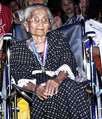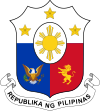National Living Treasures Award (Philippines)
| National Living Treasure Award Gawad sa Manlilikha ng Bayan (Filipino) | |
|---|---|
 Awards logo | |
| Awarded by | |
| Type | Medal |
| Awarded for | See Award |
| Status | Currently constituted |
| Sovereign | President of the Philippines |
| Statistics | |
| First induction | 1993 |
| Precedence | |
| Next (higher) | Order of Gabriela Silang |
| Next (lower) | Gawad Mabini |
| Equivalent | Order of National Artists, Order of National Scientists, Order of National Social Scientists, Order of Lakandula - Special Class of Champion for Life |
Ribbon bar of the order | |


The National Living Treasures Award, alternatively known as the Gawad sa Manlilikha ng Bayan (GAMABA; lit. 'Award for the Creators of the Country'), is conferred to a person or group of artists recognized by the Government of the Philippines for their contributions to the country's intangible cultural heritage. A recipient of the award, a National Living Treasure or Manlilikha ng Bayan is "a Filipino citizen or group of Filipino citizens engaged in any traditional art uniquely Filipino, whose distinctive skills have reached such a high level of technical and artistic excellence and have been passed on to and widely practiced by the present generations in their community with the same degree of technical and artistic competence."[1]
History
[edit]In 1988, the National Folk Artists Award was organized by the Rotary Club of Makati-Ayala. The distinctions were given by the organization until it was replaced by the GAMABA Law in 1992. The recipients of the National Folk Artists from 1988–1992 are not recognized by the government as the award was given by a private organization.[2]
The National Living Treasures Award (Gawad sa Manlilikha ng Bayan) was institutionalized in 1992 through Republic Act No. 7355.
The National Commission for Culture and the Arts, which is the highest policy-making and coordinating body of the Philippines for culture and the arts, was tasked with the implementation and awarding.[3] This is in line with UNESCO's criteria of Living National Treasures.
Criteria
[edit]To become a National Living Treasure, the candidate must possess the following qualifications:[3]
- is an inhabitant of an indigenous/traditional cultural community anywhere in the Philippines that has preserved indigenous customs, beliefs, rituals and traditions and/or has syncretized whatever external elements that have influenced it.
- must have engaged in a folk art tradition that has been in existence and documented for at least 50 years.
- must have consistently performed or produced over a significant period, works of superior and distinctive quality.
- must possess a mastery of tools and materials needed by the art, and must have an established reputation in the art as master and maker of works of extraordinary technical quality.
- must have passed on and/or will pass on to other members of the community their skills in the folk art for which the community is traditionally known.
A traditional artist who possesses all the qualities of a Manlilikha ng Bayan candidate, but due to age or infirmity has left them incapable of teaching further their craft, may still be recognized if:[3]
- had created a significant body of works and/or has consistently displayed excellence in the practice of their art, thus achieving important contributions for its development.
- has been instrumental in the revitalization of their community's artistic tradition.
- has passed on to the other members of the community skills in the folk art for which the community is traditionally known.
- community has recognized them as master and teacher of their craft.
Awards and Incentives
[edit]The Gawad sa Manlilikha ng Bayan recipients, as exemplified in Republic Act No. 7355[4] shall receive a plaque or medal bearing the logo of the award. A duplicate of this is to be donated to and permanently displayed in the pertinent provincial museum or largest cultural center.
An initial grant of One hundred thousand pesos (P100,000.00) and Ten thousand pesos (P10,000.00) a month thereafter for life. [4]
Categories
[edit]
The categories are, but not limited to, the following categories of traditional folk arts:[3]
- ethnomedicine
- folk architecture
- maritime transport
- weaving
- carving
- performing arts
- literature
- graphic and plastic arts
- ornament
- textile or fiber arts
- pottery.
- architecture
Other artistic expressions of traditional culture may be added, such as the case of the ethnomedicine category, which was added only in 2020.[5]
Recipients
[edit]

As defined by UNESCO, the bearers of intangible cultural heritage are to be known internationally as Living Human Treasures. The Filipino counterparts of this title are the Gawad sa Manlilikha ng Bayan (GAMABA) awardees.
There are currently twenty-five declared GAMABA awardees, all of which have exemplified the highest standard in their respective field of expertise.[6]
Recipients
[edit]| Image | Name | Category / declaration | Ethnic group / community | Native of | Proclamation | Year of declaration |
|---|---|---|---|---|---|---|

|
Ginaw Bilog | (For) faithfully preserving the Mangyan script and poetry by writing it on bamboo, and by promoting it in every occasion, so that this art will not be lost, but will be preserved for posterity[7][8] | Hanunuo Mangyan cultural community | Mansalay, Oriental Mindoro | Presidential Proclamation No. 383, May 17, 1994[9] | 1993 |
| Masino Intaray | As a gifted poet, musician, epic chanter and storyteller, with the Basal and Kulilal Ensemble of Makagwa Valley, has been faithfully promoting and preserving the musical and literary tradition of the Palawan people [10] | Pala’wan | Brooke's Point, Palawan | Presidential Proclamation No. 384, May 17, 1994[11] | 1993 | |
| Samaon Sulaiman | Highest excellence in the art of Kutyapi playing and manifested his unwavering dedication and commitment to his art [12] | Maguindanao | Mamasapano, Maguindanao | Presidential Proclamation No. 385, May 17, 1994 [13] | 1993 | |
| Lang Dulay | Highest excellence in the art of abaca-ikat (T’nalak) weaving and manifested her unwavering dedication and commitment to her art[14] | T'boli | Lake Sebu, South Cotabato | Presidential Proclamation No. 1189, March 27, 1998[15] | 1998 | |
| Salinta Monon | Highest level of excellence in the art of abaca-ikat (Abaca – ikat / Inabal) weaving and manifested her unwavering dedication and commitment to her art[16] | Tagabawa-Bagobo community | Bansalan, Davao del Sur | Presidential Proclamation No. 1188, March 27, 1998 [17] | 1998 | |
 |
Alonzo Saclag | Kalinga Musician and Dance [18] | Kalinga | Lubuagan, Kalinga | 2000 | |
 |
Federico Caballero | Epic Chanter of Kinaray-a and other languages [19] | Panay-Bukidnon | Sulod- Bukidnon, Iloilo | 2000 | |
 |
Uwang Ahadas | Yakan music[20] | Yakan | Lamitan, Basilan | 2000 | |
| Darhata Sawabi | Pis syabit weaving[21] | Tausūg | Parang, Sulu | 2004 | ||
| Eduardo Mutuc | Pinukpuk bronze and silver metalwork [22] | Kapampangan | Apalit, Pampanga | 2004 | ||
| Haja Amina Appi | Master mat weaver[23] | Sama-Bajau | Tandubas, Tawi-Tawi | 2004 | ||
 |
Teofilo Garcia | The Preservation Of The Native Headgear Known As The Tabungaw By Keeping The Tradition Alive In His Community[24] | Ilocano | San Quintin, Abra | Presidential Proclamation No. 474, September 13, 2012 [25] | 2012 |
 |
Magdalena Gamayo | (She) has contributed to the development of the Ilocano abel by using traditional designs in her work as well as perfecting weaving techniques that further enhance the uniqueness of these designs[26] | Ilocano | Pinili, Ilocos Norte | Presidential Proclamation No. 474, September 13, 2012 [27] | 2012 |
 |
Ambalang Ausalin | Recognized for her commitment to the safeguarding and promotion of the Yakan tennun (tapestry weaving) tradition[28] | Yakan | Lamitan, Basilan | Presidential proclamation no. 126, signed January 6, 2017 [29] | 2016 |
 |
Estelita Tumandan Bantilan | Recognized for her commitment to the safeguarding and promotion of the B'laan igem (mat weaving) tradition[30] | Blaan | Malapatan, Sarangani | Presidential proclamation no. 126, signed January 6, 2017 [29] | 2016 |
 |
Yabing Masalon Dulo | Recognized for her commitment to the safeguarding and promotion of the B'laan mabal tabih (ikat weaving) tradition[31] | Blaan | Polomolok, South Cotabato | Presidential proclamation no. 126, signed January 6, 2017 [29] | 2016 |
| Adelita Bagcal | Recognized for her commitment to safeguarding and promoting the Dallot and other ilocano oral traditions[32] | Ilocano | Banna, Ilocos Norte | Presidential Proclamation NO. 427, December 15, 2023 [33] | 2023 | |
 |
Abina Coguit | Suyam embroidery tradition of the Agusan Manobo | Agusan Manobo | La Paz, Agusan del Sur | Presidential Proclamation NO. 427, December 15, 2023 [33] | 2023 |
| Sakinur-ain Delasas | Recognized for her commitment to safeguarding and promoting the Same igal (dance) tradition[32] | Sama-Bajau | Bongao, Tawi-Tawi | Presidential Proclamation NO. 427, December 15, 2023 [33] | 2023 | |
| Bundos Fara | Recognized for his commitment to safeguarding and promoting the T'boli temwel (brasscasting) tradition[32] | T'boli | Lake Sebu, South Cotabato | Presidential Proclamation NO. 427, December 15, 2023 [33] | 2023 | |
| Marife Ganahon | Recognized for her commitment to safeguarding and promoting the Higanon ikaw (mat weaving) tradition[32] | Higaonon | Malaybalay, Bukidnon | Presidential Proclamation NO. 427, December 15, 2023 [33] | 2023 | |
| Amparo Mabanag | Recognized for her commitment to safeguarding and promoting the Ga'dang manu'bak and ameru (beadworks and embroidery) traditions[32] | Ga'dang | Paracelis, Mountain Province | Presidential Proclamation NO. 427, December 15, 2023 [33] | 2023 | |
| Samporonia Madanlo | Recognized for her commitment to safeguarding and promoting the Mandaya dagmay (ikat weaving) tradition[32] | Mandaya | Caraga, Davao Oriental | Presidential Proclamation NO. 427, December 15, 2023 [33] | 2023 | |
| Barbara Ofong | Recognized for her commitment to safeguarding and promoting the T'boli t'nalak (ikat weaving) tradition[32] | T'boli | Lake Sebu, South Cotabato | Presidential Proclamation NO. 427, December 15, 2023 [33] | 2023 | |
| Rosie Sula | Recognized for her commitment to safeguarding and promoting the T'boli lingon (chanting) tradition[32] | T'boli | Lake Sebu, South Cotabato | Presidential Proclamation NO. 427, December 15, 2023 [33] |
See also
[edit]- National Artist of the Philippines
- Art in the Philippines
- Tourism in the Philippines
- Living Human Treasure
References
[edit]- ^ Executive Order No. 236, s. 2003 Official Gazette of the Republic of the Philippines. Retrieved 14 April 2013.
- ^ "GAMABA: Gawad sa Manlilikha ng Bayan". National Commission for Culture and the Arts. Retrieved September 15, 2021.
- ^ a b c d "Briefer: Gawad sa Manlilikha ng Bayan". Official Gazette of the Republic of the Philippines. Archived from the original on January 12, 2015. Retrieved August 28, 2016.
- ^ a b "Supreme Court E-Library RA 7355".
- ^ Pag-iwayan, Jessica (November 2, 2020). "Albularyo, babaylan, and manghihilot are now considered national living treasures". Manila Bulletin. Retrieved December 21, 2023.
- ^ Manipon, Roel (January 2, 2024). "Hail the newly declared National Living Treasures". Daily Tribune (Philippines). Retrieved October 28, 2024.
- ^ "GAMABA: Ginaw Bilog". Ncca.gov.ph. Retrieved December 14, 2019.
- ^ Postma, Antoon (1995). "THE AMBAHAN: A MANGYAN POEM OF MINDORO". Philippine Quarterly of Culture and Society. 23 (1): 44–61. ISSN 0115-0243. Retrieved September 15, 2021.
- ^ "Proclamation No. 383". lawphil.net. Retrieved September 1, 2024.
- ^ "GAMABA: Masino Intaray". Ncca.gov.ph. Retrieved December 14, 2019.
- ^ "Proclamation No. 384". lawphil.net. Retrieved September 1, 2024.
- ^ "GAMABA: Samaon Sulaiman". Ncca.gov.ph. Retrieved December 14, 2019.
- ^ "Proclamation No. 385". lawphil.net. Retrieved September 1, 2024.
- ^ "GAMABA: Lang Dulay". Ncca.gov.ph. Retrieved December 14, 2019.
- ^ "Proclamation No. 1189". lawphil.net. Retrieved September 1, 2024.
- ^ "National Living Treasures: Salinta Monon - National Commission for Culture and the Arts". Ncca.gov.ph. Retrieved December 14, 2019.
- ^ "Proclamation No. 1188". lawphil.net. Retrieved September 1, 2024.
- ^ "GAMABA: Alonzo Saclag". Ncca.gov.ph. Retrieved December 14, 2019.
- ^ "GAMABA: Federico Caballero". Ncca.gov.ph. Retrieved December 14, 2019.
- ^ "GAMABA: Uwang Ahadas". Ncca.gov.ph. Retrieved December 14, 2019.
- ^ "GAMABA: Darhata Sawabi". Ncca.gov.ph. Retrieved December 14, 2019.
- ^ "GAMABA: Eduardo Mutuc". Ncca.gov.ph. Retrieved December 14, 2019.
- ^ "GAMABA: Haja Amina Appi". Ncca.gov.ph. Retrieved December 14, 2019.
- ^ "GAMABA: Teofilo Garcia". Ncca.gov.ph. Retrieved December 14, 2019.
- ^ "Proclamation No. 475". lawphil.net. Retrieved September 1, 2024.
- ^ "GAMABA: Magdalena Gamayo". Ncca.gov.ph. Retrieved December 14, 2019.
- ^ "Proclamation No. 474". lawphil.net. Retrieved September 1, 2024.
- ^ "National Living Treasures: Ambalang Ausalin - National Commission for Culture and the Arts". Ncca.gov.ph. March 4, 1943. Retrieved December 14, 2019.
- ^ a b c "Proclamation No. 126". lawphil.net. Retrieved September 1, 2024.
- ^ "Manlilikha ng Bayan - Estelita Bantilan". Ncca.gov.ph. October 17, 1940. Retrieved December 14, 2019.
- ^ "National Living Treasures: Yabing Masalon Dulo - National Commission for Culture and the Arts". Ncca.gov.ph. August 8, 1914. Retrieved December 14, 2019.
- ^ a b c d e f g h Presidential Proclamation No. 427, s. 2023 (December 15, 2023), Declaring nine (9) individuals as Manlilikha ng Bayan for 2023 (PDF), retrieved December 21, 2023
- ^ a b c d e f g h i "Proclamation No. 427". lawphil.net. Retrieved September 1, 2024.
External links
[edit] Media related to Recipients of orders, decorations and medals of the Philippines at Wikimedia Commons
Media related to Recipients of orders, decorations and medals of the Philippines at Wikimedia Commons

